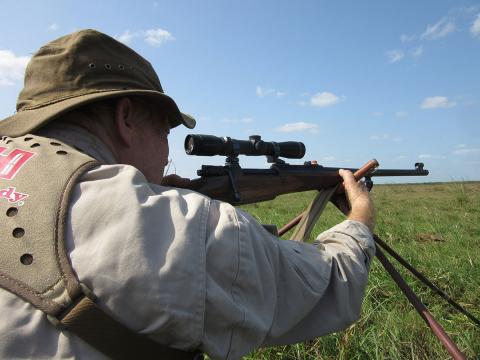.416 – Best Bet For The Biggest Big Game
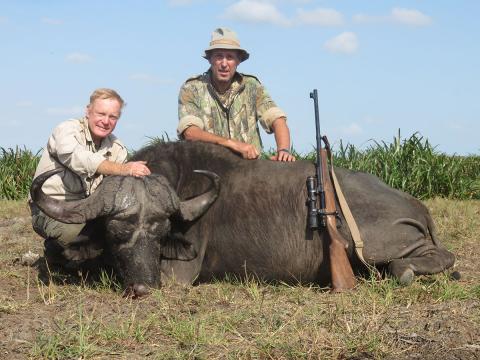
The morning air was chill as we poled silently down the channel, hearing the dawn chatter of birds and monkeys as we glided past palm islands. We turned a corner and a buffalo bull stood on the bank, alone, mature, good bosses, nice curl. Ronnie MacFarlane ground his pole into soft mud and I did the same, getting some stability with one hand while I reached for the rifle in the prow. I hit him on the shoulder with the first shot, then again as he turned away. Hit hard, the bull vanished into thick growth near the bank. The cover opened up in just a few yards and that’s where we found him.
A couple of weeks later, Peter Johnstone and I approached a bachelor group of elephants feeding in dense mopane. We had already picked our bull, clearly the biggest and probably the oldest, a giant towering above his buddies, but tuskless, which is what we were looking for. Peter led us in…this was happening fast and my palms were slick with sweat in the evening cool. A couple of smaller bulls passed…and then the big bull stepped forward. He seemed to tower above us and I tried to remember my orders: “Eye, earhole, hand’s breadth in front of the earhole.”
I tried to work the bolt fast, but I was already too late; the elephant was down and still before I could bring the rifle to bear, and it was all over. The buffalo was my first buffalo with a .416. Jack Atcheson Jr. and I started in Botswana’s Okavango, then shifted to Matetsi in northwest Zimbabwe; it was my first elephant, another first with a .416.
TOO GOOD TO DIE!
The year was 1985. The cartridge I was using was George Hoffman’s wildcat .416 Hoffman, in a time when there were no factory loads for any .416 cartridges…and few bullets. Good old American handloaders were keeping classic calibers alive, thanks to Fred Huntington at RCBS for the dies…and Randy and Coni Brooks at Barnes Bullets. The bullet I used on the buffalo was a Barnes Original, 400 grains, heavy copper jacket and lead core. Better expanding bullets—from Barnes and others—were just around the corner, but the old Original worked fine. The elephant was taken with Barnes’ new homogenous alloy “Super Solid,” first of a whole new breed of bullets. Shooting uphill, the 400-grain bullet entered just in front of the earhole and exited on the opposite side. To my knowledge it is still going.
John Rigby brought out his famous .416 in 1911, 410-grain bullet at fast (for the day) 2,370 fps, developing about 5,000 ft-lbs of energy. It quickly achieved a fantastic reputation. Walter Bell (best-known as a small-bore man) ordered a pair just before WWI. George Rushby, John Hunter, John Kingsley-Heath and Harry Selby are among other famous names who used the .416 Rigby. Despite the legend, the .416 Rigby was actually uncommon. Retained as a proprietary cartridge, rifles and ammo were only available from Rigby. The big Rigby case required an extra-large magnum action; supply was limited, and costs were high.
Total Rigby production of .416s ran into the few hundreds. After WWII the British Empire shrank rapidly as colonies gained independence. The British gun trade reached its nadir, and Kynoch discontinued the big Nitro Express cartridges. Rigby did their best to keep their .416 alive with special runs of ammo, but cartridges, brass and bullets became scarce. Enter American handloaders. Jack O’Connor had a .416 Rigby; he made brass by turning the belts off of .460 Weatherby brass on a lathe.
Of course, with RCBS dies and Barnes bullets, American handloaders weren’t constrained by little details like case dimensions. Using existing cases, a number of non-standard or wildcat cartridges were developed using the .416 bullet. In the 1970s the most popular was the .416 Taylor, developed by American gunwriter Robert Chatfield-Taylor and based on the .458 Winchester Magnum case necked down. Able to fit into a .30-06-length action, with the propellants then available the .416 Taylor lacked the powder capacity to quite equal the .416 Rigby—but it came pretty close. Gunwriter John Wootters was a huge fan of the .416 Taylor; largely through his urging it almost became a factory cartridge twice, but didn’t quite happen.
In the late1970s American PH George Hoffman wildcatted his .416 Hoffman based on the full-length .375 H&H case necked up. Hoffman’s cartridge needed a .375 H&H-length action, but his cartridge equaled the .416 Rigby and pretty much set the “new” standard for .416 ballistics: 400-grain bullet, 2,400 fps, 5,115 ft-lbs of energy. In the early 2000s, when it was really no longer necessary, I had a .416 Taylor, but it was George Hoffman’s cartridge that introduced me to the .416 in the mid-Eighties.
THE .416 FLOOD
By then things were changing fast. New brass was available from Jim Bell’s Brass Extrusion Laboratories Ltd. (BELL) and from Art Alphin’s A-Square. Bullet choices in .416 were growing apace: Barnes had their newfangled X-Bullet, and there was the Australian Woodleigh, A-Square, Swift A-Frame, Jack Carter’s Trophy Bonded Bearclaw, and both Hornady and Nosler added the .416 bullet diameter.
I had my first .416 Rigby at that time, a Dumoulin. It was still a bit of a novelty when I took it to Tanzania in 1988…but not for long. Working fast and quietly, Remington struck first in late 1988 with their .416 Remington Magnum. Without question they used George Hoffman’s work and their cartridge was almost identical to his…except Remington used their own 8mm Remington Magnum case, with a slightly different neck and less body taper. George Hoffman never forgave them…but he still deserves much credit for the .416 revival. Remington followed Hoffman’s recipe: 400-grain bullet at 2,400 fps.
Bill Ruger was also a .416 fan…and a bit of an Anglophile. He wanted a magnum version of his Model 77 that could house the .416 Rigby. Federal made the ammo, initially using Woodleigh bullets and precisely following John Rigby’s formula: 410-grain bullet, 2,370 fps, 4,990 ft-lbs of energy. At the same time Federal brought out a modern load for the .470 Nitro Express, so it wasn’t just the .416 that was being revived in that crazy year of 1988-1989!
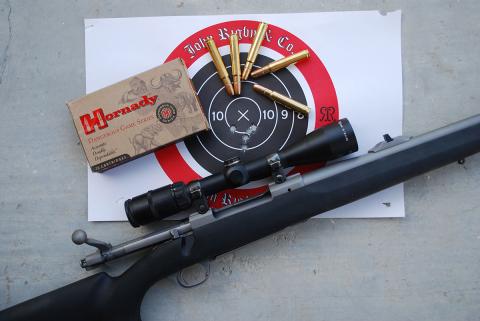
Rounding things out, in mid-1989 Weatherby necked their .460 Weatherby Magnum down to .416, creating the .416 Weatherby Magnum. This was Ed Weatherby’s first cartridge after the death of his father, Roy Weatherby, in 1988. Their .378/.460 case is dimensionally the same as the .416 Rigby case, except the Weatherby version wears a belt. Combining 1911-vintage propellants with use in the tropics, .416 Rigby ammo was always loaded to low pressure. The .416 Remington is loaded to higher pressure…as is the .416 Weatherby. The.416 Weatherby is much faster, with 400-grain bullet at 2,600 to 2,700 fps, yielding more than 6,000 ft-lbs. In late spring 1989 Ed Weatherby and I used his new cartridge in Botswana, taking several buffaloes. Performance was awesome, but please note that, when you add a couple hundred more feet per second recoil goes up sharply!
Now, suddenly, we had plenty of choices. Rather than an oddball limited to handloaders, the .416 was a common caliber!
MAGIC IN THE NUMBER?
John Rigby was an astute ballistician and brilliant engineer, but exactly why or how he settled on the .416-inch bullet diameter seems to have been lost. Although his exclusive arrangement with Mauser would soon end, when he designed his .416 he was the sole importer of magnum Mauser actions, so he was not constrained by case dimensions.
As for the bullet diameter, there were other choices. Jeffery introduced their .404 in 1909. Their designation uses the smaller land (rather than groove or bullet) diameter. Actual bullet diameter was .423-inch, already established in Europe as the 10.75mm. The Jeffery case could be crammed into a .375-length action. Initial loadings were mild, duplicating .450/.400 ballistics in a bolt-action. Adopted by several African game departments, the. popular .404 Jeffery was made in numbers that far exceeded the .416 Rigby. And, when .416 Rigby ammo was almost unavailable, .404 Jeffery (10.75x73mm) ammo was still loaded in Germany.
The .450/.400’s .410-inch bullet offered another choice. There is a bit of controversy regarding this bullet diameter. Older .450/.400 Nitro Express rifles, in both three-inch and 3.25-inch versions, can vary in bullet diameter, some as tight as .409-inch and others as loose as .412-inch. When creating their modern .450/.400-3” load Hornady settled on .410-inch as the best compromise. All current rifles are so bored, but there are also .411-inch bullets available (which is the correct diameter for the old .405 Winchester.
In the days before the .416 revival both .410/.411-inch bullets and .423-inch bullets were used for American wildcat and proprietary cartridges. The .411 KDF used a .411-inch bullet, as does the .400 H&H (developed in 2003). The wildcat .425 Express, developed by Cameron Hopkins and Whit Collins, uses a .423-inch bullet.
Are any of these diameters “better”? This is a silly argument. Sectional Density (SD) of the 400-grain .416 bullet is a very high .330; SD of the 400-grain .423-inch bullet is slightly lower at .319; and SDs of the 400-grain .410-inch bullet is slightly higher at .340. All of these SDs exceed that of the 300-grain .375, SD .305, a bullet well-known for great penetration. Depending on which diameter, there’s a maximum spread of only .007-inch between .416 and .423 This is the same difference between the .270 (.277-inch) and the 7mm (.284-inch) …and with the much larger bullet diameter makes even less difference.
The .450/.400, with a 400-grain bullet at about 2,100 fps, is much slower and produces less energy, about 4,000 ft-lbs. It offers an effective low-recoil option in double rifles. The rest of the group, including the more recent .500/.416 (Krieghoff), .416 Ruger (Hornady/Ruger), and current loads for the .404 Jeffery, all propel 400-grain bullets somewhere between 2,350 and 2,400 fps, with energies at or approaching 5,000 ft-lbs. No buffalo or elephant will notice a difference of 50 feet per second one way or the other.
WHY A “.40-SOMETHING”?
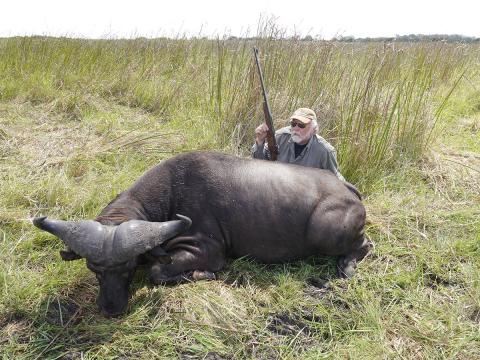
Primarily because they work! I must be careful here. I don’t want to imply that our baseline cartridge, the .375 H&H, isn’t fully adequate for buffalo. It is. However, the various lower .40s with, 400-grain bullets at roundabout 2,400 fps, produce more energy—and do it with heavier bullets with greater frontal area. They do produce more recoil, so it’s important to be honest when you look in the mirror: Can you shoot such a cartridge well? If the answer is yes, then, over time, you will take more buffaloes with fewer shots, do less tracking and incur less risk than if you were using a .375 (or its European equivalent, a 9.3mm).
There are significant differences. A .416 (or similar) is more difficult to shoot well than a .375 and does not shoot as flat. With practice, a scoped .416 can certainly be used on plains game out to 250 yards or so, but it is not as versatile as a .375 for plains game.
The greater difference, however, is that a .416 (or similar) is much more effective on the upper end. While perfectly adequate for buffalo, I believe the .375 is marginal for hippo and elephant. The .416s (and similar) are not only perfectly adequate for the very largest game…but just might be better than a true big-bore of .450-plus. Start with: They have less recoil, thus are easier to shoot well. Plus, they are much more versatile, perfectly acceptable for a one-rifle safari battery, while a big bore is not.
More to the point, in the rarified air of hunting the world’s largest game, they can out-perform the big-bore cartridges. Velocity overcomes resistance, and frontal area creates more resistance. A 400-grain .416 at 2,400 fps will generally out-penetrate, say, a 500-grain .475 bullet at 2,150 fps. Energy yield for both is 5,000 ft-lbs, always a good rule of thumb for the largest game. However, the faster .416 bullet uses its higher velocity to overcome resistance; and its smaller-diameter bullet encounters less resistance. In testing I’ve done in ballistic wax the .416s always out-penetrate the slower big-bores.
Far more importantly, I’ve seen solids from the great Nitro Express cartridges, consistently about 2,150 fps, fail to penetrate on elephant, especially with the tricky frontal brain shot. I’ve never seen a .416 solid at 2,400 fps fail to penetrate. Of course, you can increase the velocity on a big bore. The .458 Lott approaches .416 velocity; the .450 Rigby Rimless Magnum, .460 Weatherby Magnum, and behemoths like the .500 Jeffery and .505 Gibbs can equal (or exceed) .416 velocities. The problem is the recoil becomes too much for many of us. The .416s are much more shootable, especially in a rifle of adequate weight (ten pounds or more).
WHICH ONE TO CHOOSE?
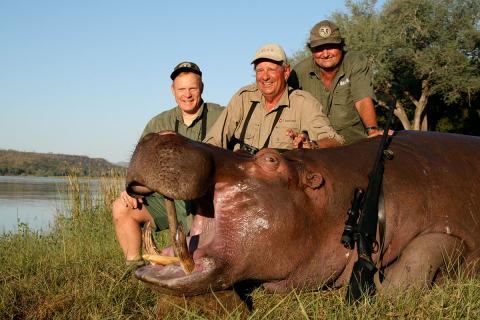
Over the years I’ve hunted with most of the .416s and their brethren, and I’ve had all of them on the range. Performance is, if not equal, too similar to call. In terms of ammo availability, the .416 Rigby and Remington are the most common, probably followed by the .404 Jeffery; most of the rest are available from more limited sources. If you run toward tradition and nostalgia, then either the .416 Rigby or .404 Jeffery will have the most appeal. If budget is a concern (in both rifles and ammo) then the .416 Remington or .416 Ruger are sound options.
One comment: These modern cartridges are loaded to higher pressures than the .416 Rigby. The .500/.416 is loaded to lower pressure for use in doubles, and the .400 H&H is purposefully loaded down a bit. There is a rumor out there that, because of its higher pressure, the .416 Remington can have sticky extraction. I’ve used it at high temperatures in Cameroon, the Zambezi Valley and coastal Mozambique. I’ve never seen a problem, and I’ve never heard a first-hand report. As near as I can tell that’s just a story…but you don’t want to expose any ammunition to direct sunshine, especially in hot climates.
I don’t have a .416 right now, but I do have a .404 Jeffery. I’ll probably have another .416, and since I have a bent for nostalgia, it will probably be a .416 Rigby. They’re all good, and on game much the same. So, take your pick, and be confident it will do the job…provided you do yours.–Craig Boddington


